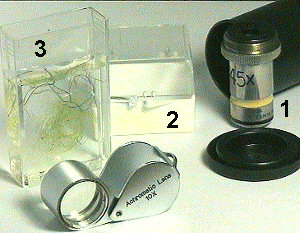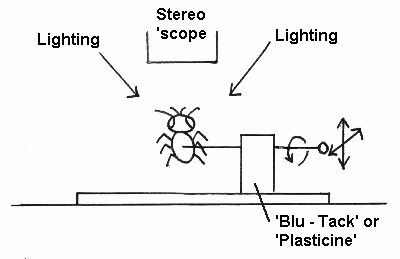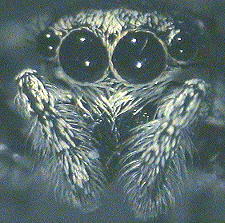 - They're just the right size for safely storing
objectives and smaller eyepieces that often fit snugly inside
(number 1, image right).
- They're just the right size for safely storing
objectives and smaller eyepieces that often fit snugly inside
(number 1, image right).Topical Tips
compiled by Dave Walker
I'm sure we've all acquired tips, techniques, 'tricks of the trade' or perhaps made simple gadgets while pursuing the fascinating hobby of amateur microscopy. Whether you're a novice, beginner or experienced amateur, why not share some of these with us? They don't need to be original, but I'm sure they'll be of interest to others who may not have come across them. Just send us a short note in an email, enclosing a scanned picture or drawing if you wish and we would be pleased to compile, upload and acknowledge your contributions. (See page footer for Editor contact).
To kick this series off, here's a few of mine ... nothing very original I'm afraid but may be of interest!
Use your Web browser back button to return to this Index, or scroll down.
Keep those containers - new uses for 35mm film canisters, cover-slip boxes and .... 'Tic-Tac' mint boxes!
Insect manipulator - to view insects etc under a stereo' and take 'portrait' photos.
Pond or stream nets - for collecting macroscopic invertebrates.
Keep
those containers
35mm film cassette containers have a multitude
of uses:
 - They're just the right size for safely storing
objectives and smaller eyepieces that often fit snugly inside
(number 1, image right).
- They're just the right size for safely storing
objectives and smaller eyepieces that often fit snugly inside
(number 1, image right).
- Carry a few 35mm canisters when out on a walk. They can be used to safely carry back home interesting and possibly fragile subjects for the microscope eg dead insects, scrap of moss, flower heads etc .
- Plastic cover-slip boxes are great 'bug boxes' for studying live insects, spiders etc and for showing these 'bugs' to friends and children before safely releasing (number 2, image right).
- 'Tic-Tac' or similar mint boxes are useful pond-side mini-aquariums for studying pond water. Their small size and flat sides make studying macroscopic pond life by eye or with a hand lens much easier and for showing to kids (number 3, image right . (Use isopropanol (2-propanol) if available to remove the glue of the label).
- not to mention the larger ice cream tubs which are ideal for dust-free storage of those larger bits and pieces like monocular tubes, spare condensers etc.
 Well that's perhaps too grand a description for a piece
of 'Blu -Tack' or 'Plasticine' with a pin stuck through it! Many
times I've wanted to manipulate a small dead insect or spider
under a low power stereo microscope to obtain the required
viewing angle. I've often found it tricky, especially when
viewing them face-on while releasing hands for focusing and
photography.
Well that's perhaps too grand a description for a piece
of 'Blu -Tack' or 'Plasticine' with a pin stuck through it! Many
times I've wanted to manipulate a small dead insect or spider
under a low power stereo microscope to obtain the required
viewing angle. I've often found it tricky, especially when
viewing them face-on while releasing hands for focusing and
photography.
 Impaling the hapless creature on the end of a pin and
supporting the middle of the pin in 'Blu -Tack', allows the other
end of the pin to be rotated and twisted in all three planes to
get just the right angle for viewing. With the shallow depth of
field a photo' can be taken without seeing the pin. In the best
traditions of the TV cooks, 'here's one I prepared earlier'
(image left shows the 'face' of a jumping spider).
Impaling the hapless creature on the end of a pin and
supporting the middle of the pin in 'Blu -Tack', allows the other
end of the pin to be rotated and twisted in all three planes to
get just the right angle for viewing. With the shallow depth of
field a photo' can be taken without seeing the pin. In the best
traditions of the TV cooks, 'here's one I prepared earlier'
(image left shows the 'face' of a jumping spider).
Pond
or stream nets for collecting macroscopic invertebrates
If you like collecting and examining the macroscopic creatures in a pond or stream, the finer mesh plankton nets are not required. A 1mm mesh net will collect the majority of insect larvae, beetles and larger crustacea such as shrimps and water louse.
Specialist commercial nets for collecting the larger aquatic invertebrates can be quite expensive. However, quite serviceable nets for can be made at home using materials to hand.
 A stout sieve bag with a 1mm mesh size is often sold
for sieving the coarser fines from 'home brews'. The larger
drugstores which sell 'home brew' materials may sell them (eg
'Boots the Chemist' in the UK). The 'Boots' bag is 17 cm square
so only needs shortening in length (eg to 22 cm) and sewing onto
a square metal frame.
A stout sieve bag with a 1mm mesh size is often sold
for sieving the coarser fines from 'home brews'. The larger
drugstores which sell 'home brew' materials may sell them (eg
'Boots the Chemist' in the UK). The 'Boots' bag is 17 cm square
so only needs shortening in length (eg to 22 cm) and sewing onto
a square metal frame.
The net the author made in this fashion is shown left (numbered 1). The stout stainless steel tubing (1/4 inch gas pipe) for the frame was found in a junk yard, with a threaded T-piece to attach a metal handle. A rummage through your garage or junk yard may find some suitable material for a rigid frame. The adjustable clips for car radiator hoses can be used to secure the frame onto a suitable handle.
The net numbered 2 is a commercial net from an aquarist and is useful for sampling areas where a larger net is impractical eg very small streams or very shallow ponds. Articles discussing some of the techniques and equipment for Stream Dipping (from which the image left was taken) and Pond Dipping are in the Micscape Library.
So ... that's a few of my tips ..... it's
now over to you. I await your tips with interest - simple or
sophisticated, one or many, I'm sure our readers will be
interested to see them!
Why not send one now (see contact below).
Note that a variety of articles on simple techniques and home made projects for the amateur microscopist can be found in the Micscape Library (look under 'Novice' or 'Techniques'). Also see Larry Legg's Learner Page for simple slide making techniques (from where the title images where taken).
Please report any Web problems
or offer general comments to the Micscape Editor,
via the contact on current Micscape Index.
Micscape is the on-line monthly
magazine of the Microscopy UK web
site at Microscopy-UK